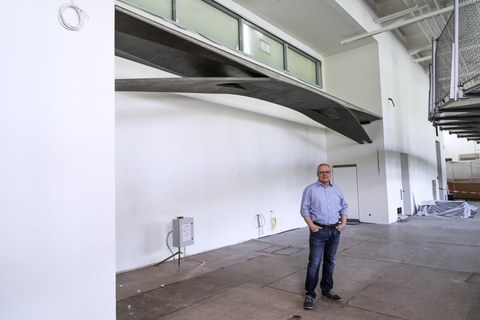Aug 30, 2021
Carbon concrete bridge successfully erected at the Deutsches Museum

Manfred Curbach in front of the carbon reinforced concrete bridge in the Deutsches Museum
Scientists from the Institute of Concrete Structures build an impressive bridge that exemplifies the spectrum of carbon reinforced concrete construction methods.
In the context of the "Future Initiative", the general renovation and modernisation [1]of the Deutsches Museum in Munich [2] , even more space is being given to promising innovations. This now includes a bridge made of carbon reinforced concrete as an exhibit in the bridge and hydraulic engineering department.
With a length of 9.50 m and a width of 1.20 m, the carbon reinforced concrete bridge is designed as a filigree construction consisting of two flat inclined supports and a three-part superstructure. The design and constructional possibilities of lightweight construction with concrete and carbon reinforced concrete are demonstrated above all by the slender v-shaped supports and the construction weight of only 2.1 tonnes. The force-flow-optimised shape and the sandwich structure of the superstructure.
The three-layer structure varies in height between 60 and 160 mm. The biaxially curved underside and the flat upper side consist of a 20 mm thick layer of carbon reinforced concrete. The layer in between consists of infralight concrete with a density of approx. 800 kg/m³.
Based on 3D modelling of the bridge, the geometry was optimised in terms of load transfer and construction, and formwork made of shaped plywood. After successful production and sampling of an identical test specimen, the two supports and the lower shells of the three-part superstructure were manufactured in the Otto Mohr Laboratory [3] and transported to the installation site at a height of approx. 3 m in Munich to the Deutsches Museum. For this purpose, the filigree elements were supported on wooden substructures and a height-adjustable and horizontally movable support system was built on a working platform. After positioning the five bridge segments, the edge formwork was mounted and infra-light concrete was placed as an intermediate layer on site. The bridge was completed with a top layer of carbon reinforced concrete. Four weeks later, the support structure could be removed. Since then, the exhibition bridge has been an independent construction and fully loadable. The concrete surfaces were finally cleaned and impregnated, which further enhanced the appearance of the filigree construction.
The bridge is already the second exhibit made of carbon reinforced concrete to enrich the Deutsches Museum. Since 2017, the permanent exhibition for the Deutscher Zukunftspreis des Bundespräsidenten [4] (German Future Prize of the Federal President) has included the module for the innovation "Carbon reinforced concrete, a fascinating material - economical, efficient, attractive"[5] , which was awarded in 2016.
The carbon reinforced concrete bridge was created as a demonstrator for Priority Programme 1542 "Concrete light. Future concrete structures using bionic, mathematical and engineering formfinding principles (SPP 1542)"[6] , which was funded by the Deutsche Forschungsgemeinschaft [7] (DFG, German Research Foundation).
The project was also supported by the companies Heidelberger Beton GmbH [8] and HICONFORM - Freitaler Modellwerkstätten eG [9]as well as the Institute for Building Materials at TU Dresden [10] and the Institute for Solid Construction at TU Munich [11]. Special thanks go to the staff of the Deutsches Museum for the exhibition opportunity and on-site support.
The carbon reinforced concrete bridge can be viewed in the Bridges and Water Engineering Department of the Deutsches Museum from the planned reopening at the end of 2021/beginning of 2022. The exhibition on the German Future Prize will also be accessible there again.
Press contact:
Sandra Kranich
Phone: +49 351 484 56 714
Quellen:
[1]https://modernisierung.deutsches-museum.de/en
[2]https://www.deutsches-museum.de/en
[3]https://tu-dresden.de/bu/bauingenieurwesen/imb/labor?set_language=en
[4]www.deutscher-zukunftspreis.de/de/team-1-2016
[5]www.bauen-neu-denken.de/erstmalig-in-der-geschichte-des-deutschen-museums-exponat-aus-carbonbeton/
[6]https://tu-dresden.de/bu/bauingenieurwesen/imb/forschung/Forschungsfelder/Betone-Bauweisen/aeltere-projekte/SPP_1542#
[7]https://www.dfg.de/en/index.jsp
[8] https://www.heidelbergcement.de/de/beton
[9]https://www.hiconform.de/
[10]https://www.tu-dresden.de/bu/bauingenieurwesen/ifb
[11]https://www.bgu.tum.de/en/mb/home/
